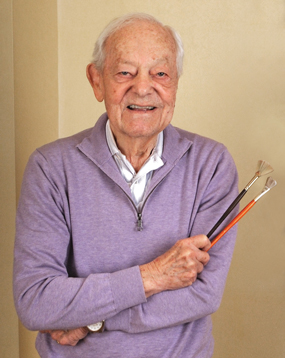
In his first-ever solo exhibition this spring at the American University Museum, renowned journalist Bob Schieffer debuted 25 paintings quite literally ripped from the headlines.
The eight-time Emmy winner, who spent 47 years at CBS News—nearly half of them as moderator of Face the Nation—took up drawing as a child in Fort Worth, Texas, sitting on the porch of his grandmother’s home and sketching the cows. Schieffer continued to nurture his hobby even as his journalism career kicked into high gear, attending classes at New York’s Art Student League in the 1980s while he was working the early shift at CBS News.
But he didn’t pick up a paintbrush until early 2020, when, he says, “One problem piled on another for the nation.”
As COVID-19 began its horrible march across the US, Schieffer clipped photos and headlines from the New York Times, Washington Post, and Wall Street Journal—“an admittedly odd habit I developed years ago”—and retreated to the art studio he commandeered in the dining room of the Northwest Washington condo he shares with his wife of 57 years, Patricia. There, the longtime chronicler of history began to process what he was witnessing—the pandemic, the murder of George Floyd, the January 6 insurrection—with oil on canvas.
“In a sense, all artists are reporters, interpreting the world around them in a way we can learn from and respond to,” says Jack Rasmussen, CAS/MFA ’75, MA ’83, PhD ’94, the C. Nicholas Keating and Carleen B. Keating Director of the AU Museum. “Bob Schieffer is not only one of the greatest journalists, he is a compelling artist able to speak from his professional experience and his heart.”
Even amid “a difficult and dangerous period,” Schieffer says individuals like ousted US representative Liz Cheney (R-WY), infectious disease expert Anthony Fauci, and Ukrainian president Volodymyr Zelensky stepped up. Theirs are among the acts of courage depicted in Looking for the Light, named for a line from Youth Poet Laureate Amanda Gorman’s “The Hill We Climb,” delivered at President Biden’s 2021 inauguration.
“Somehow, in her calm and measured way, [Gorman] broke through the chaos and confusion” of the moment, Schieffer says. “I was moved by those words, [which] inspired me to find hope in a dark time.” The 87-year-old’s debut exhibition is, at its core, “a plea for civility,” he says.
Schieffer’s friend, presidential historian Michael Beschloss, who curated the exhibition, says the broadcaster “has long been known and honored for his ability to see into the souls of the people he covers and interviews”—an art form of its own that shone through the paintings that adorned the AU Museum Project Space from April 6 to May 19.
“[His] paintings are to news photographs as history is to journalism,” says Beschloss, and demonstrate “how—and how deeply—Bob Schieffer understands the American story and how intensely he dreams of what our American experiment can still become.”

Portrait of the Artist as an Old Man (2021) “I liked Norman Rockwell before it was cool. It was George Lucas who called him a ‘one-frame storyteller,’ and there has never been a better one. I still smile when I see the Rockwell self-portrait, which I parodied in this painting.”
The Face of Evil (2022) “Of all the images I have collected over the years, this was the easiest to title and required the least explanation. I have no idea who first painted it, but I discovered that it appeared on hundreds of Ukrainian protestors’ signs. I hope they will not mind my helping to spread their message.”
The Unforced Error: Leaving the Graveyard of Empires (2021) “President Biden believed it was time to bring American soldiers home from Afghanistan, our longest war. He gave the order during his first year, expecting a dignified exit, unlike America’s chaotic departure from Vietnam. The departure from Afghanistan was far worse. Thirteen Americans were killed as they guarded the airport, and many Afghan allies who had been promised safe passage out discovered they were on their own.”
The Poet (2021) “The poem that Youth Poet Laureate Amanda Gorman delivered at the Biden inauguration ends, ‘For there is always light. If only we’re brave enough to see it. If only we’re brave enough to be it.’ It was her way of telling us that we have overcome seemingly impossible challenges throughout our history, but it was a reminder as well that no form of government is invulnerable, and that democracy must be nourished by each generation.”

The Bump (2020) “After President Biden won the election, his followers poured into Lafayette Square, where Jabin Botsford got an extraordinary photo, which I used as a basis for this painting. I laid over it a painting based on a photo of Barack Obama and Joe Biden pumping elbows by Demetrius Freeman. The images symbolize the joy that so many felt that night.”
One Million Dead (2022) “By May 15, 2022, it was official. The pandemic had taken more than a million American lives, roiled our economy, and left many Americans questioning the historic institutions on which our country was founded.”
Say His Name (2020) “[After] America watched George Floyd die on television, the uncertainty, toxic politics, and disagreements of the COVID-19 era left the country in a dispirited mood and helped reignite the Black Lives Matter movement. It came to a boil as protestors argued that police treated people of color differently than Whites.”

Remarkable Heroes of Our Time (2021–23) “The headlines of the COVID-19 era were often crowded with the rantings of bad actors of all stripes, but the era also marked the passing of some remarkable people. Among the four I most admire are John McCain, Sandra Day O’Connor, John Lewis, and Ruth Bader Ginsburg.”